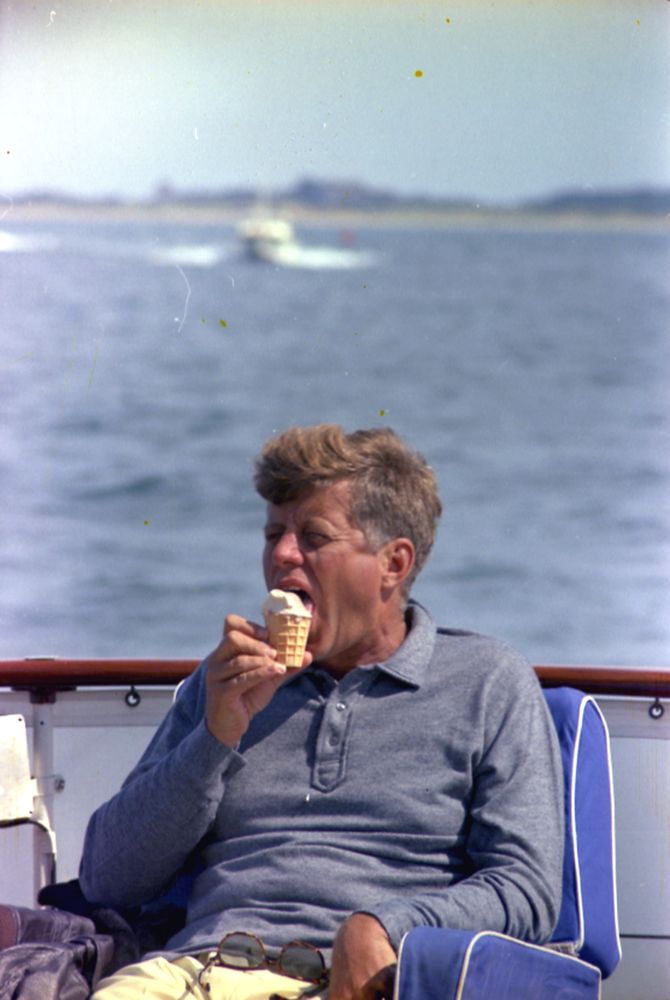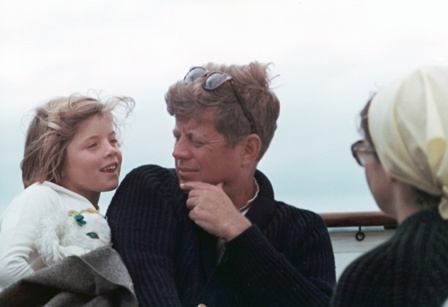The American Presidents
June 15, 2018
By Mark E. Griffin
There is a set of photos of John Fitzgerald Kennedy on vacation with his family in late-summer of 1963. In one shot, JFK’s sitting on his boat, “Honey Fitz,” lazily licking an ice cream cone that drips onto his hand. Maybe it’s the slouchy, casual way JFK sat in chairs while eating ice cream, but in this photo, he looks just like… a dad.
Any dad.
It’s an accessible moment from one of the most powerful people on the planet during one of the world’s most pivotal times. And it’s a uniquely American moment precisely because JFK seems so relatable — if that photo could be a picture of your dad, or mine, then hey, maybe anyone’s parents could be president, right?
It’s also accessible in more ways than one. Want to download that photo and stick it on your desktop at work? Go for it.
Want to email it to your dad with the subject line “Dad?” in it? You’re welcome.
The John F. Kennedy Presidential Library and Museum started making digitized material related to its name-sake’s life and presidency available online in 2011, several years after the library began digitizing the 25 million some-odd pages of documents, photos, film, video, and audio recordings it had in its archives.
Digital archives may exist as a series of ones and zeroes, but even they can get dusty, too. Systems that hold these files together can become obsolete, and applications not nimble enough to change with the times languish. That can leave staffers wondering how much time, effort, and resources it might take to change with the times.
“At the pace that the JFK Library was completing this work, it would have taken a thousand years to digitize, catalog, and make accessible the entire library,” says Kara Van Malssen, AVP partner and senior consultant.
To shorten that timespan and improve the processes while adding value to these historical artifacts, AVP took a look under the hood.
“Having done a lot of work around digitization, our team knows what it takes to figure out where the bottlenecks are appearing, and then help them refine these processes,” says Van Malssen.
Building potential scenarios for improvement is an important step towards defining and accomplishing these larger goals.
 “In this case, we outlined five scenarios that charted paths and outcomes for the digitization, dissemination, and preservation of the JFK Library collection over a five-year period,” says Chris Lacinak, AVP founder and president. “These scenarios explored different possibilities for scope of digitization and metadata creation, approaches to technological infrastructure (e.g., cloud vs. on-premise storage), and associated costs, including the internal resources that would be required to fulfill each scenario.”
“In this case, we outlined five scenarios that charted paths and outcomes for the digitization, dissemination, and preservation of the JFK Library collection over a five-year period,” says Chris Lacinak, AVP founder and president. “These scenarios explored different possibilities for scope of digitization and metadata creation, approaches to technological infrastructure (e.g., cloud vs. on-premise storage), and associated costs, including the internal resources that would be required to fulfill each scenario.”
In the end, the JFK Library Foundation, which supports the Library’s digitization program, chose a step-by-step path forward, starting with the selection of a digital asset management system (DAMS), the tool for organizing and cataloging the whole collection, that can openly communicate with the JFK Library website, social media, email newsletters, and more. Then comes matching up a robust storage system that would be compatible, flexible, and scale as the digital archive grows.
Finding a photo from a recent vacation is not hard to do visually, but picking out photos or documents from a set of millions in the JFK Library collection can be exponentially tougher. To make them easier to catalog for online access, the JFK Library is setting up a system enabling the addition of metadata, which may include artificial intelligence. This makes it possible to identify context, with user permissions allowing for any set of people to see.
Now, with a several long-term plans to consider, the JFK Library Foundation is working on developing a digitization roadmap, while showing incremental progress to donors and stakeholders who see the value of this work.
“The research that AVP prepared will allow the John F. Kennedy Library Foundation to move forward with new technology and expand the amount of resources that can be digitized,” says Steven M. Rothstein, executive director of the John F. Kennedy Library Foundation. “Their work has been critically important in this process.”
“Making this information accessible means individuals will be able to question the materials in whatever way that they want, from analysis of JFK’s handwriting to scientists taking aggregate information to understand patterns and decision-making during the beginning of the Vietnam War,” says Van Malssen. “But it won’t enrich society if it’s not digitized, well described, and made accessible through modern technology.”